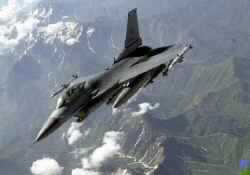WASHINGTON (AP) - By firing a surface-to-air missile at an American U-2 spy plane over southern Iraq, President Saddam Hussein's government has signaled a significant change in its targeting strategy against patrolling U.S. and British planes, officials said.
The high-flying U.S. plane was not hit, but the missile flew so close Wednesday that the plane's pilot felt the reverberations from the explosion.
White House officials were not inclined Thursday to read a lot of significance into the incident.
The intelligence plane was flying as part of Operation Southern Watch, a U.S.-British operation patrolling ``no-fly'' zones over Iraq, Pentagon spokesman Lt. David Gai said.
The operation, in place since the Gulf War ended in 1991, is designed to protect Kurdish and Shiite groups from government forces. Iraq disputes the legitimacy of the flight-interdiction operations and regularly contests U.S. and British patrols by firing missiles and artillery guns.
Less than a week ago, the crew of a Navy E2-C surveillance aircraft flying in Kuwaiti airspace reported seeing the plume of a surface-to-air missile fired from inside Iraq. That plane also was not hit in what has become almost a daily - and potentially deadly - game of cat-and-mouse between the two sides.
U.S. officials are interpreting the new attacks on U.S. surveillance aircraft as a significant shift in Iraq's tactics. Rather than take aim at patrolling warplanes, officials say the Iraqis are choosing now to go after the slower-moving monitoring craft. The high-performance fighter jets have continually evaded Iraqi missiles since the flight-interdiction operation began in 1991 after the Persian Gulf War.
The U-2 operates at an altitude of more than 70,000 feet, beyond the range of most surface-to-air missiles. CBS News, which first reported the incident, said U.S. officials believe the Iraqis have modified some of their missiles, adding extra fuel to extend their range.
In Wednesday's incident, the pilot of the Air Force U-2 saw an anti-aircraft missile streak toward him before it exploded nearby. The explosion was close enough for the pilot to feel the shock wave but not to damage the plane, the Air Force official said.
Although he said the pilot felt ``some concussion,'' he said the airman was asked to rank on a scale of one to 10 - with 10 being most likely - whether he thought the missile could have hit him. The pilot answered: ``One.''
Over the past three years, Iraq has occasionally claimed to have hit a U.S. or British plane, but no downing has been confirmed.
Last month, a U.S. Navy fighter jet attacked an anti-aircraft artillery site in southern Iraq in what U.S. military officials called a response to the frequent attacks on the U.S. and British patrols.
PHOTO CAPTION:
FILE--A U.S. F-16 flies over partly snow-covered mountains near the Turkey-Iraq border during a mission to patrol the no-fly zone in Iraq in this June 19, 2001 file photo. A U.S. F-16 fighter jet crashed in southeastern Turkey on Wednesday, July 18, 2001, as it was heading towards northern Iraq to patrol a no-fly zone. According to the U.S. military officials, the pilot ejected from the aircraft, but there was no immediate information on whether he had been rescued. (AP Photo/Burhan Ozbilici/File)
- Jul 18 11:05 AM ET
- Author:
AP - Section:
WORLD HEADLINES


 Home
Home Discover Islam
Discover Islam Quran Recitations
Quran Recitations Lectures
Lectures
 Fatwa
Fatwa Articles
Articles Fiqh
Fiqh E-Books
E-Books Boys & Girls
Boys & Girls  Women
Women










